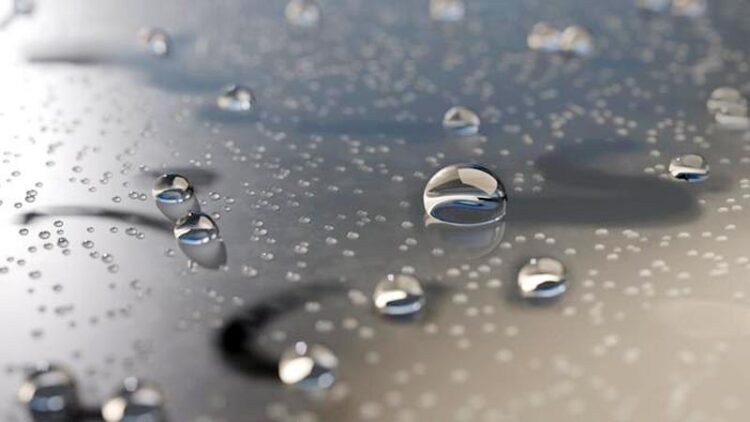Dancing droplets’ new spin on water harvesting

The Cheerios effect is a process where small floating objects cluster together on the surface of a liquid. Researchers optimized this process to increase condensation rates for efficient water-harvesting systems.
Credit: © 2024 KAUST; Ivan Gromicho
A more efficient way to capture fresh water from the air could be inspired by a phenomenon of motion first glimpsed in bowls of breakfast cereal.
KAUST researchers have observed that, when water droplets condense from the air onto a cold surface coated with oil, the droplets commence a complex dance.[1] This motion — akin to a process known as the Cheerios effect whereby the floating cereal tends to cluster due to surface tension — could help to speed up the harvesting of water from the atmosphere in arid regions such as Saudi Arabia.
“We are interested in designing surfaces that can promote condensation of water, which has important heat-transfer and water-harvesting applications,” says Marcus Lin, a research fellow in the lab of Dan Daniel, who led the research. On a typical solid surface, condensed droplets stick to the surface with minimal motion. “Think of water condensing on a cold soda can,” says Lin. “The droplets only move once they grow big enough for gravity to pull them down.”
Daniel, Lin and their collaborators had the idea that adding a thin film of oil would lubricate the surface, resulting in highly mobile droplets that would free up space for further droplet condensation, boosting condensation rates. The idea worked — but the complex ways in which the droplets moved was a complete surprise, Daniel says.
Once the droplets grew to a critical size, they began to move across the oil in a distinct pattern akin to an elaborate dance. “They initially moved in a serpentine manner, before transitioning into circular motions, and then back again,” says Lin. “These motions occurred across scales ranging from micrometers to several centimeters, and they lasted for hours.”
The driving force for the process is that — like Cheerios in milk — water droplets floating on the oil are drawn toward their neighbors. The larger droplets’ motion is driven by energy released as they swallow up smaller droplets in their path.
The moving droplets redistribute the oil film and switch from a serpentine to a circular motion when the film becomes locally depleted. Once the local oil rebuilds, the snake-like dance resumes.
Such devices that can efficiently capture water from the air by simple condensation, with no energy input, are widely sought as pressure grows on freshwater sources, Daniel says. “By optimizing the collective motion of condensing droplets, we can greatly increase condensation rates and hence design more efficient water-harvesting systems,” he says.
The team plans to further explore the mechanisms driving droplet motion, particularly investigating the transition from serpentine to circular movement. “Another key aspect is to explore potential applications, particularly in heat-transfer enhancement and water harvesting,” Lin adds.
REFERENCE
- Lin, M., Kim, P., Arunachalam, S., Hardian, R., Adera, S., Aizenberg, J., Yao, X. & Daniel, D. Emergent collective motion of self-propelled condensate droplets. Physical Review Letters 132, 058203 (2024).| article
Journal: Physical Review Letters
DOI: 10.1103/PhysRevLett.132.058203
Article Title: Emergent Collective Motion of Self-Propelled Condensate Droplets
Article Publication Date: 1-Feb-2024
All latest news from the category: Physics and Astronomy
This area deals with the fundamental laws and building blocks of nature and how they interact, the properties and the behavior of matter, and research into space and time and their structures.
innovations-report provides in-depth reports and articles on subjects such as astrophysics, laser technologies, nuclear, quantum, particle and solid-state physics, nanotechnologies, planetary research and findings (Mars, Venus) and developments related to the Hubble Telescope.
Newest articles

A universal framework for spatial biology
SpatialData is a freely accessible tool to unify and integrate data from different omics technologies accounting for spatial information, which can provide holistic insights into health and disease. Biological processes…

How complex biological processes arise
A $20 million grant from the U.S. National Science Foundation (NSF) will support the establishment and operation of the National Synthesis Center for Emergence in the Molecular and Cellular Sciences (NCEMS) at…

Airborne single-photon lidar system achieves high-resolution 3D imaging
Compact, low-power system opens doors for photon-efficient drone and satellite-based environmental monitoring and mapping. Researchers have developed a compact and lightweight single-photon airborne lidar system that can acquire high-resolution 3D…





















